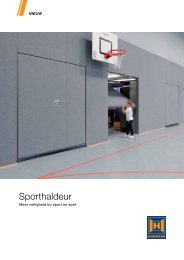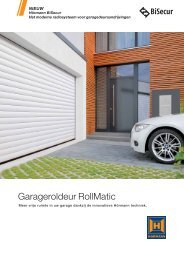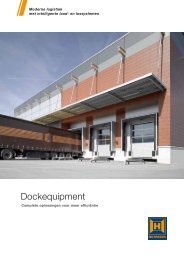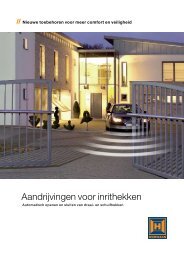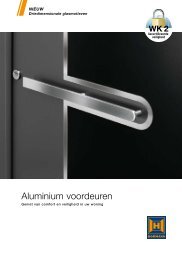Anleitung für Montage, Betrieb und Wartung Installation ... - Hormann
Anleitung für Montage, Betrieb und Wartung Installation ... - Hormann
Anleitung für Montage, Betrieb und Wartung Installation ... - Hormann
Create successful ePaper yourself
Turn your PDF publications into a flip-book with our unique Google optimized e-Paper software.
ENGLISH<br />
Reducing the setting is only advisable if a light-moving<br />
door is involved, a higher level of safety is desired and<br />
"normal" operation is guaranteed (must be established<br />
through testing).<br />
ATTENTION<br />
If the potentiometer is set too low, this<br />
will put the operator out of action!<br />
Note<br />
Besides having the task of limiting the maximum forces<br />
(during the OPEN reference cycle and CLOSE learn cycle<br />
and serving as an upper limit for updating), both potentiometers<br />
also have a second function:<br />
- P1: during a normal opening cycle over the last centimetres<br />
before reaching the OPEN end-of-travel position,<br />
P1 assumes the task of the programmed force limit,<br />
thereby making it possible to adjust doors which require<br />
a greater force at this stage only.<br />
- P2: during a normal closing cycle, after passing the limit,<br />
from which point on no reversing takes place (so called<br />
reversing limit, located just before reaching the CLOSE<br />
end-of-travel position), P2 assumes the task of the programmed<br />
force limit, thereby making it possible to adjust<br />
doors which require a greater force at this point to ensure<br />
tight closing.<br />
3.4 Other adjustment options (Warning phase,<br />
Automatic closing, options relay)<br />
With the "A" and "B" DIL-switches (accessible on removing<br />
the operator cover, see figure 10 and 17), the following<br />
functions of the operator and options relay can be set:<br />
40<br />
DIL-switch "A" at OFF / DIL-switch "B" at OFF<br />
- Operator / operator lighting: normal function.<br />
- Options relay: the relay picks up with the operator<br />
lighting, but without cycling.<br />
Note: Factory setting; Connection of additional external<br />
operator lighting (see figure 16).<br />
DIL-switch "A" at OFF / DIL-switch "B" at ON<br />
- Operator / operator lighting: normal function.<br />
- Options relay: the relay picks up on reaching the<br />
CLOSE end-of-travel position.<br />
Note: "Close" signal.<br />
DIL-switch "A" at ON / DIL-switch "B" at OFF<br />
- Operator: Warning phase (approx. 2 s) always active.<br />
- Operator lighting: flashes rapidly during warning phase.<br />
- Options relay: cycles rapidly during warning phase;<br />
"normal" cycling continues when door in motion.<br />
Note: Connection of an external warning light (without<br />
automatic flashing) (see figure 16).<br />
DIL-switch "A" at ON / DIL-switch "B" at ON<br />
- Operator: Warning phase (approx. 2 s) always active.<br />
Automatic closing from OPEN end-of-travel position<br />
after 30 s open phase and approx. 2 s warning phase.<br />
- operator lighting flashes rapidly during warning phase<br />
- Options relay: Relay cycles slowly during the open<br />
phase and rapidly during the warning phase; "normal"<br />
cycling continues when door in motion.<br />
Note: Connection of an external warning light without<br />
automatic flashing (see figure 16).<br />
Explanation:<br />
Warning phase<br />
The time from when the command to move is given until<br />
the door starts to move. If a new command is given during<br />
this time, the warning phase ends without being followed<br />
by a subsequent travel cycle.<br />
Open phase<br />
The time the door waits at the OPEN end-of-travel limit.<br />
If a command to move is given during this time, the open<br />
phase starts anew.<br />
Automatic closing<br />
The door automatically closes after a set time after reaching<br />
the OPEN end-of-travel position. Pre- requisite is the<br />
fitting of a photocell and/or closing edge safety device!<br />
3.5 Connecting the additional components<br />
Notes on work involving electrics - Attention!<br />
The following points apply to all work<br />
involving electrics:<br />
- Electrical connections may only be made by a<br />
qualified electrician!<br />
- On- site electrical installation must comply with<br />
the relevant safety regulations (230/240 V AC,<br />
50/60 Hz)!<br />
- Before working on the operator, always unplug<br />
from the mains!<br />
- External voltage at any of the controls connecting<br />
terminals will completely destroy the electronics<br />
(exception terminal .6, .5, .8)!<br />
- To avoid malfunctions, ensure that the control<br />
cables of the operator (24 V DC) are laid in an<br />
installation system separate to other supply<br />
lines (230/240 V AC)!<br />
To connect the additional components, the operator cover<br />
must be removed (see figure 10). The terminals to which<br />
the remote control or additional components such as<br />
potential-free internal and external buttons, OFF-switch<br />
or wicket door contact as well as safety devices such as<br />
photocell or closing edge safety device are connected,<br />
carry a safe low voltage of only 30 V DC max.<br />
All connecting terminals are designed for multiple<br />
occupancy, however, please observe the maximum<br />
of 1 x 1.5 mm 2 (see figure 10.2). Before connection,<br />
always pull out the mains plug!<br />
3.5.1 Connecting the remote control<br />
The remote control is to be connected as follows:<br />
Plug-in connection (see figure 11)<br />
The receiver unit plug is plugged into the corresponding<br />
plug-in location on the operator head.<br />
06.2004 TR10A014 RE



